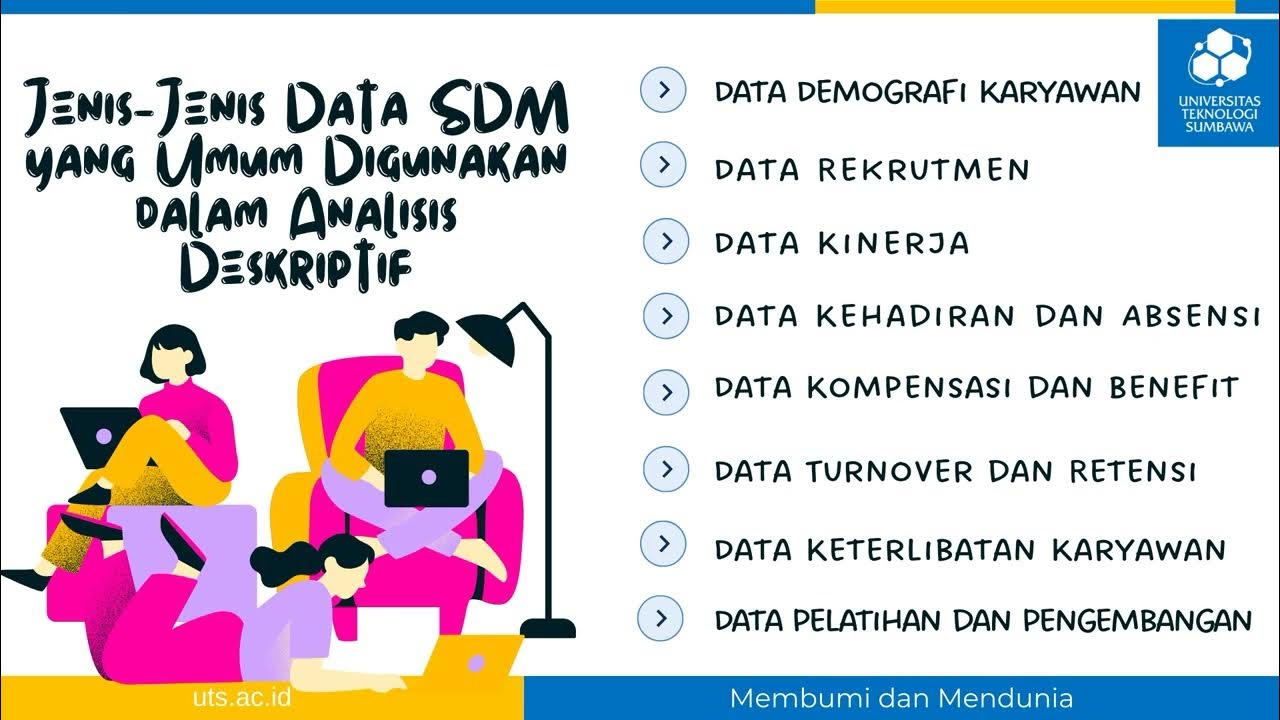Pertemuan ke 4 Analisis SDM
Summary
TLDRThis video provides an in-depth overview of key Human Resource (HR) metrics crucial for effective employee management. It covers various aspects such as recruitment, employee engagement, retention, performance evaluation, and training development. The video emphasizes the importance of using specific metrics like employee value, goal tracking, and training effectiveness to enhance productivity, develop employees, and ensure fair reward systems. Additionally, it highlights the significance of HR data for strategic decision-making and concludes with a reminder to avoid drug use, promoting a healthy lifestyle.
Takeaways
- 😀 HR metrics are crucial for analyzing and improving human resource management practices in an organization.
- 😀 Employee recruitment and engagement metrics help assess the efficiency of hiring processes and the effectiveness of employee retention strategies.
- 😀 Metrics like employee retention rate and turnover rate are vital for understanding workforce stability and engagement.
- 😀 Revenue per employee is a key metric to gauge the average contribution of employees to the company's revenue.
- 😀 Performance and potential metrics categorize employees based on their current performance and future potential for targeted development strategies.
- 😀 Employee performance can be evaluated through various methods such as performance reviews and 360-degree feedback.
- 😀 Goal tracking ensures that employees' individual goals align with organizational objectives, improving focus and overall performance.
- 😀 Company performance metrics help evaluate if high-performing employees receive appropriate rewards and recognition.
- 😀 Training and development metrics assess the effectiveness and efficiency of employee development programs.
- 😀 Metrics such as training expenses per employee help track the budget allocation for employee development, ensuring proper investment in training.
- 😀 Training completion rate and training effectiveness metrics are essential for evaluating the success and impact of employee training programs.
- 😀 HR metrics should be seen as valuable insights rather than just numbers, helping organizations make informed, strategic decisions for workforce management.
Q & A
What is the main purpose of using HR metrics in an organization?
-HR metrics are used to assess the effectiveness, efficiency, and performance of Human Resource functions, helping organizations make data-driven decisions that improve employee productivity, engagement, and overall company success.
How is the 'Revenue per Employee' metric useful?
-'Revenue per Employee' measures how much each employee contributes to the company’s overall revenue, allowing organizations to gauge employee productivity and compare performance across different departments or teams.
What does the 'Performance and Potential' metric measure?
-The 'Performance and Potential' metric categorizes employees based on their current performance and future potential, enabling companies to develop tailored strategies for talent management, such as providing mentorship or training to high-potential employees.
Why is it important to track 'Employee Performance'?
-Tracking 'Employee Performance' ensures that employees are fulfilling their job responsibilities effectively. It helps companies assess individual contributions, identify performance gaps, and determine areas for improvement.
What does 'Goal Tracking' tell us about employees?
-Goal Tracking monitors the achievement of goals set by employees, ensuring their efforts are aligned with organizational objectives. It helps organizations measure progress, maintain focus on priorities, and assess the impact of individual contributions on company success.
How does 'Company Performance' help evaluate employee rewards?
-The 'Company Performance' metric compares employee performance to the rewards or recognition they receive. It helps ensure that high-performing employees are rewarded appropriately and that the reward system is fair and effective.
Why is it important to evaluate 'Training and Development' programs?
-Evaluating 'Training and Development' programs ensures they are effective in improving employee skills, knowledge, and performance. It helps identify areas for improvement in training strategies and ensures that resources are invested efficiently.
What does the 'Training Expenses per Employee' metric measure?
-This metric tracks the total cost of training and development programs for each employee, helping organizations monitor and control their training budgets while evaluating whether the investment in training aligns with the results achieved.
How is the 'Training Completion Rate' used to evaluate a training program?
-The 'Training Completion Rate' measures the percentage of employees who complete a training program. A high completion rate indicates that the training is well-received and employees are motivated to learn, while a low rate may suggest barriers or disinterest.
What is the significance of 'Training Effectiveness'?
-'Training Effectiveness' assesses whether training programs improve employee knowledge, skills, and overall performance. It is measured through various methods such as feedback, tests, or performance reviews to determine the success of the program.
Outlines

Esta sección está disponible solo para usuarios con suscripción. Por favor, mejora tu plan para acceder a esta parte.
Mejorar ahoraMindmap

Esta sección está disponible solo para usuarios con suscripción. Por favor, mejora tu plan para acceder a esta parte.
Mejorar ahoraKeywords

Esta sección está disponible solo para usuarios con suscripción. Por favor, mejora tu plan para acceder a esta parte.
Mejorar ahoraHighlights

Esta sección está disponible solo para usuarios con suscripción. Por favor, mejora tu plan para acceder a esta parte.
Mejorar ahoraTranscripts

Esta sección está disponible solo para usuarios con suscripción. Por favor, mejora tu plan para acceder a esta parte.
Mejorar ahoraVer Más Videos Relacionados

Rahasia dibalik Strategi Pengembangan SDM di PT. Telekomunikasi Indonesia (Persero) Tbk

10 Fungsi Manajemen Sumber Daya Manusia (Learn HR Series)

FG 6_Manajemen Operasional dan SDM

Gestão de Recursos Humanos: 6 principais atividades do RH | RH Academy

Analisis SDM Pertemuan 3

Module 14 - Video 1 - HR Information Systems
5.0 / 5 (0 votes)
